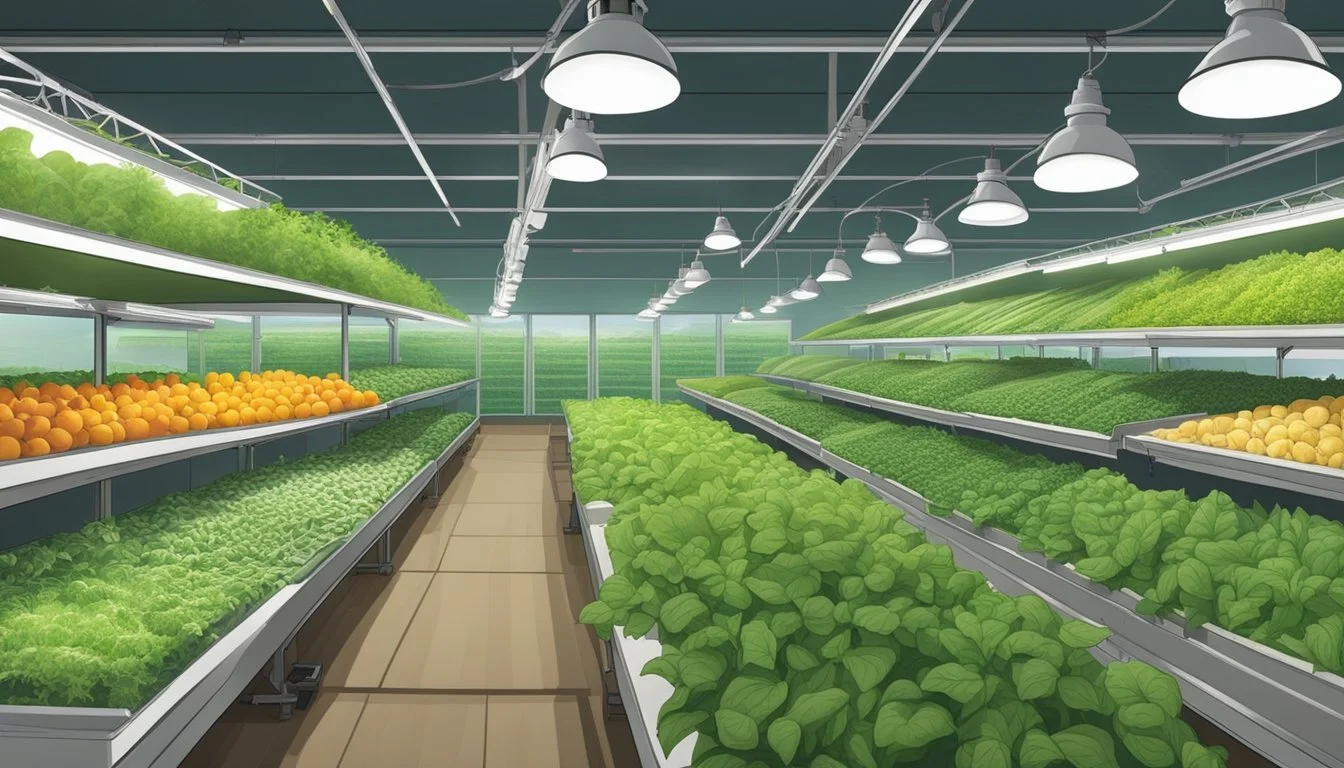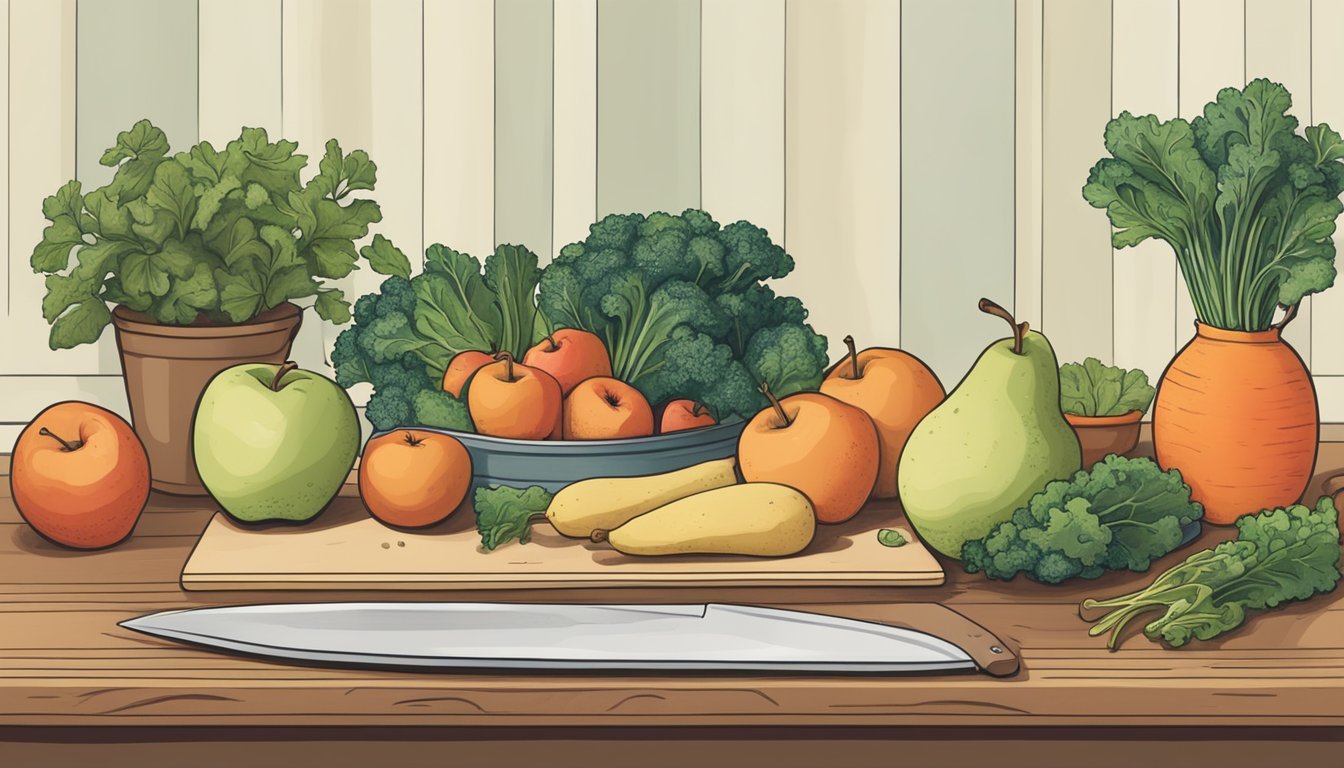Maine Seasonal Fruit & Vegetables in January
A Guide to Winter Produce
This Article is Part of our Maine Seasonal Fruit & Veg Calendar
In the heart of winter, Maine's agricultural offerings reflect the resilience and adaptation of its farmers to the northeastern climate. January in Maine boasts a hearty selection of produce that can withstand the chill, providing locavores and culinary enthusiasts with options to create nutritious and flavorful dishes. Root vegetables and stored crops take center stage during this time of year, offering both sustenance and a taste of local terroir.
Maine's local markets and farms present an array of fruits and vegetables that thrive in the cold or are available due to advanced storage techniques. Apples (how long do apples last?), a staple in the Maine harvest, continue to be accessible thanks to controlled atmosphere storage which extends their shelf-life well into the winter months. Root vegetables such as beets carve out a significant presence, known for their earthy flavor and versatility.
Beyond root vegetables, January also sees the availability of greenhouse-grown produce and meats. Local beef, another year-round staple, provides an excellent source of protein against the winter cold. These items are testament to the state's commitment to a sustainable food system that brings locally grown and raised food to the tables of Maine residents throughout the seasons.
Understanding Maine's Seasonal Produce Cycle
In Maine, the availability of fresh produce is largely influenced by the natural seasons. During winter months, such as January, the array of in-season crops is different from what one might find in the summertime.
The Role of Seasons in Crop Availability
Seasons play a pivotal role in determining the types of crops that can be harvested at any given time in Maine. The state's climate, characterized by its cold winters and relatively short growing season, necessitates careful planning and often the use of season extension techniques, such as greenhouses, to ensure a year-round supply of produce. Farmers adjust their planting schedules and employ protective measures to cater to the demands of each season, which affects the availability of local produce throughout the year.
January Produce Overview
In January, the heart of Maine's winter, the local produce selection is more limited due to the harsh weather conditions. However, resilient and cold-tolerant crops are available, which provide fresh food options even during the coldest months. The following table presents a selection of Maine produce typically available in January:
Fruits Vegetables Apples Beets Cabbage Carrots (how long do carrots last?) Celeriac Garlic Leeks
These crops survive well in the cold and can be stored for extended periods, ensuring a continuous supply. Additionally, Maine farmers make use of indoor growing facilities to produce greens and other vegetables that would not normally survive the winter outdoors. This ingenuity allows for fresh local produce despite the challenges presented by the season.
Fruits Available in Maine During January
In the midst of Maine's cold winters, options for local seasonal fruits are limited. The staple fruit readily available during this time is the apple, celebrated for its robustness and versatility.
Apples
Maine offers a variety of apples during January, thanks to both late-harvest varieties and effective storage methods that keep them fresh. Common types found in local markets include McIntosh, Cortland, and Honeycrisp. These apples are prized for their crisp texture and a balance of sweet-tart flavors suitable for both eating fresh and cooking.
Storage Techniques for Winter Fruits
Farmers and distributors in Maine use sophisticated storage techniques to prolong the shelf life of apples through the winter months. Controlled atmosphere storage (CAS) is a key method, where oxygen levels, temperature, and humidity are meticulously regulated to slow down the ripening process, keeping the apples in a state of suspended animation. This technology allows consumers to enjoy locally-grown apples long after the harvest season has ended.
Vegetables to Enjoy in January in Maine
January in Maine offers a robust selection of cold-tolerant vegetables, providing both hearty flavors and nutrition during the winter months. Root vegetables and leafy greens are particularly abundant, each offering a variety of options for seasonal cooking.
Root Vegetables
Potatoes: A staple in Maine, potatoes are versatile and available in several varieties during January. They can be baked, mashed, or used in hearty stews.
Carrots: Sweet and crunchy, carrots are a nutritious choice, ideal for roasting or adding to soups.
Beets: Earthy and deep-colored, beets can be enjoyed roasted, or pickled, adding vibrant flavor to winter dishes.
Parsnips: With a sweet nutty flavor, parsnips are excellent when roasted or pureed into soups.
Onions and Garlic: Essential for flavor, both onions and garlic are available and are used as fundamental ingredients in many dishes.
Sweet Potatoes: Rich in flavor and nutrients, sweet potatoes can be baked, roasted, or incorporated into casseroles.
Winter Squash: Varieties like butternut or acorn squash are abundant, perfect for soups, baking, or stuffing.
Pumpkins: Though not as commonly eaten post-autumn, pumpkins are still available and can be used in a range of savory and sweet dishes.
Leafy Greens & Brassicas
Spinach: Fresh and tender, spinach is suitable for salads or can be cooked for a warm side dish.
Cabbage: Hearty and versatile, cabbage can be used in slaws, sautéed, or made into fermented dishes like sauerkraut (how long does sauerkraut last?).
Kale: Nutrient-dense kale is a popular green that can be used in salads, soups, or as a crispy snack when baked.
Brassicas (Broccoli, Cauliflower): These nutrient-rich vegetables are excellent when steamed, roasted, or added to stir-fries.
Scallions: Also known as "spring onions," scallions can be used to add a fresh, oniony flavor as a garnish or integrated into a variety of dishes.
Throughout January, Maine's local produce provides a wealth of vegetables to enrich the winter table, with each vegetable adding its own unique flavor, texture, and nutritional benefits.
Indoor Farming and Off-Season Produce
Maine farmers utilize advanced indoor farming techniques to provide fresh produce during the colder months. They focus especially on greens, herbs, and a selection of vegetables that thrive in controlled environments.
Hydroponics and Greenhouses
Hydroponic systems in Maine allow for the cultivation of various lettuces and herbs throughout the year. These soilless methods rely on nutrient-rich water solutions to grow plants. For example:
Lettuces: Includes varieties such as romaine, butterhead, and oak leaf.
Herbs: Cilantro, basil, and parsley are common.
Greenhouses, on the other hand, trap heat and sunlight, extending the growing season of many crops. This method enables Maine farmers to produce:
Greens: Spinach and kale can be grown even during the colder months.
Berries: Although more challenging, some greenhouses support berry production, albeit in smaller quantities than traditional methods.
Exotic and Out-of-Season Vegetables
Maine's indoor farming ventures also grow vegetables that are typically not in season during January. Controlled environments create pockets of suitable climates within the state. A few examples include:
Tomatoes: Thriving in warm conditions replicated in greenhouses.
Peppers: With proper lighting and heating, these can be grown off-season.
Specialty crops like baby carrots and beets, which are small and mature quickly, are well-suited for greenhouse cultivation.
Indoor farming methods are vital for providing Maine residents with a variety of fresh produce, defying the natural constraints of winter.
Local Agriculture and Farmers' Markets
January in Maine presents a unique challenge for local agriculture, but farmers' markets continue to provide access to Maine-grown produce through the winter months. These markets support resilient farm operations and offer fresh, seasonal foods to the communities.
Supporting Maine Farmers
During the colder season, Maine farmers often extend the availability of crops through storage and greenhouse methods. Communities can support these local farmers by purchasing Maine-grown produce which may include storage-tolerant vegetables such as apples, beets, cabbage, and carrots. Farmers' markets in various cities provide an avenue for farmers to connect directly with consumers, fostering a sustainable economic environment.
Farmers' Market Shopping Tips
When shopping at Maine's farmers' markets in January, consumers can expect to find winter-harvested and stored goods. The Maine Organic Farmers and Gardeners Association (MOFGA) recommends asking vendors about their growing practices and the current availability of crops. Here are a few tips for market shopping:
Ask vendors about the variety and seasonality of their produce.
Plan visits to the market, such as the Portland Farmers' Market or others, based on updated schedules, since some operate on limited winter hours.
Utilize local tips from seasoned shoppers or market staff for the best purchase choices.
Through these practices, both farmers and consumers benefit from a robust network that values the connection between agriculture and community in Maine.
Seasonal Recipes and Preparation Ideas
In January, Maine's bounty of seasonal produce can be transformed into heartwarming dishes and healthy meals. Utilizing fresh vegetables and fruits in culinary creations not only provides rich flavors but also nourishes the body during the colder months.
Winter Comfort Foods
During the chilly days of winter, warming comfort foods make the most of Maine’s January produce. One might find solace in a hearty root vegetable stew, simmered with turnips, beets, parsnips, and carrots harvested in the late fall and stored for winter use. Rich in flavor and warmth, these stews pair well with robust kale or collard greens (how long do collard greens last?), which maintain their hearty texture even in soups.
Baked acorn or butternut squash, filled with a mixture of wild rice (how long does wild rice last?), cranberries, and nuts (how long do nuts last?), presents another comforting option. Squashes, with their sweet, nutty flesh, are excellent vessels for savory fillings and complement the flavors of the season.
Healthy New Year Dishes
For those seeking healthier options without compromising on taste, Maine's January produce offers plenty of inspiration. A vibrant citrus-kale salad utilizes the zest and juice of fresh citrus fruits, such as lemons and oranges, along with crisp kale, to make a refreshing and vitamin-packed dish.
One can also prepare broccoli and cauliflower rice, where these nutrient-rich vegetables are grated to resemble rice grains and sautéed with garlic and herbs for a low-carb side dish. Combining these with seared sea scallops (What wine goes well with scallops?)—a local favorite—creates an elegant entrée full of protein and essential vitamins.
By focusing on the simple preparation of fresh, local ingredients, one can enjoy a range of satisfying and healthful dishes that celebrate the best of Maine's winter produce.
Storing and Preserving Maine's January Produce
January in Maine offers a robust selection of produce that can sustain despite the cold climate. Proper storage and preservation methods are essential for extending the longevity and quality of these products.
Canning and Freezing
Canning is a reliable way to preserve the harvest's bounty. Maine's January produce such as apples and beets can be canned as jams, jellies, or pickled products.
Apples: Can be turned into applesauce or apple butter and canned for later use.
Beets: Pickled beets are a popular canned treat, retaining their earthy flavor.
Freezing is another preservation method suitable for January produce. Carrots, for instance, can be blanched and frozen to maintain their freshness and nutritional value. Garlic, although not commonly frozen, can be minced and stored in oil or butter in the freezer.
Root Cellars and Storage Tips
Root cellars are ideal for storing many of Maine's hardy January produce, taking advantage of the natural cooling and humidity conditions to extend their shelf life.
Apples: Store in a cool, dark place; ideal cellar temperature is between 30-40°F. Beets, Carrots, and Celeriac: These should be kept in a humid condition to prevent shriveling. Sand or peat moss can be used to maintain humidity levels and separate the vegetables, preventing rot.
Maine's January climate inherently offers the cool temperatures needed to effectively use root cellars or similar storage environments such as basements or unheated garages. Produce such as garlic and dry beans are stored well in mesh bags or bins, allowing for air circulation and maintaining dry conditions. It is recommended to check on stored items regularly and remove any that show signs of spoilage to prevent it from affecting the rest.
Understanding Organic and Sustainable Farming in Maine
Maine has been a significant player in the organic movement, offering a supportive landscape for farmers who adhere to sustainable and organic farming practices.
Organic Certification Process
To be recognized as an organic operation in Maine, farmers must comply with specific standards that cover the farming system's production, processing, and handling. Organic certification involves:
Application and inspection: Farmers submit an application to a USDA-accredited certifying agent and undergo a thorough inspection process.
Record-keeping: Extensive records must be maintained for all management practices and materials used.
Annual review: Certification requires an annual review to ensure continued compliance with organic standards.
Benefits of Sustainable Practices
Engaging in sustainable farming practices presents numerous benefits, which include:
Environmental Protection: It helps in conserving water, reducing soil erosion, and maintaining soil fertility.
Economic Viability: Farmers often benefit from lower input costs over time and may receive premium pricing for their organic products.
Community Building: Sustainable practices tend to foster stronger community ties through local food systems and shared commitments to environmental stewardship.
Utilizing sustainable methods, Maine farmers play a crucial role in maintaining the ecological balance while contributing to the state's agricultural diversity.









